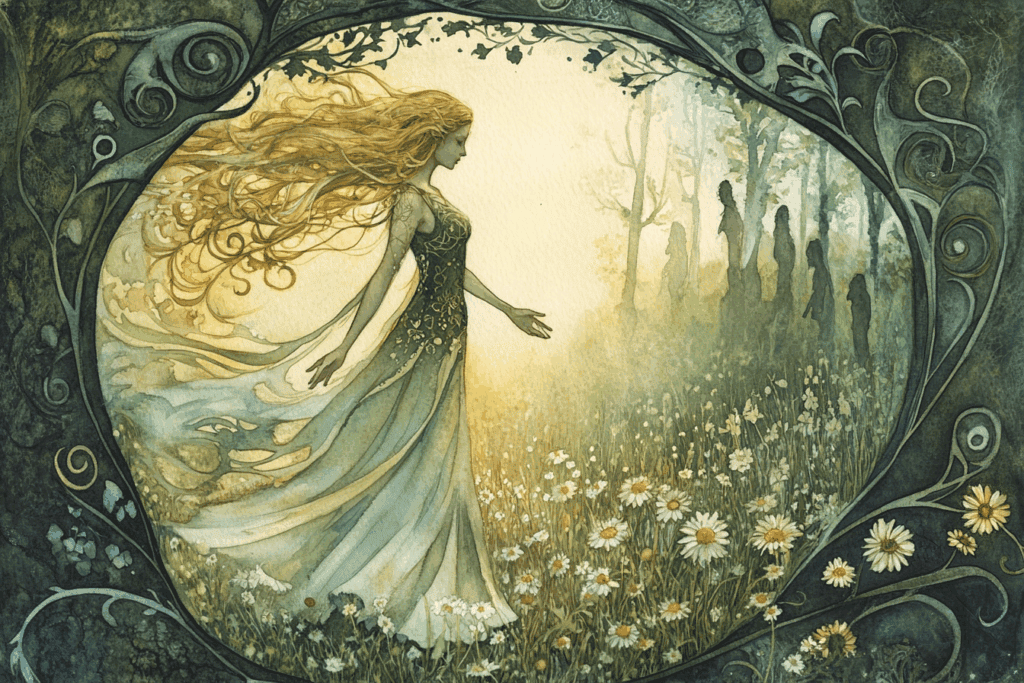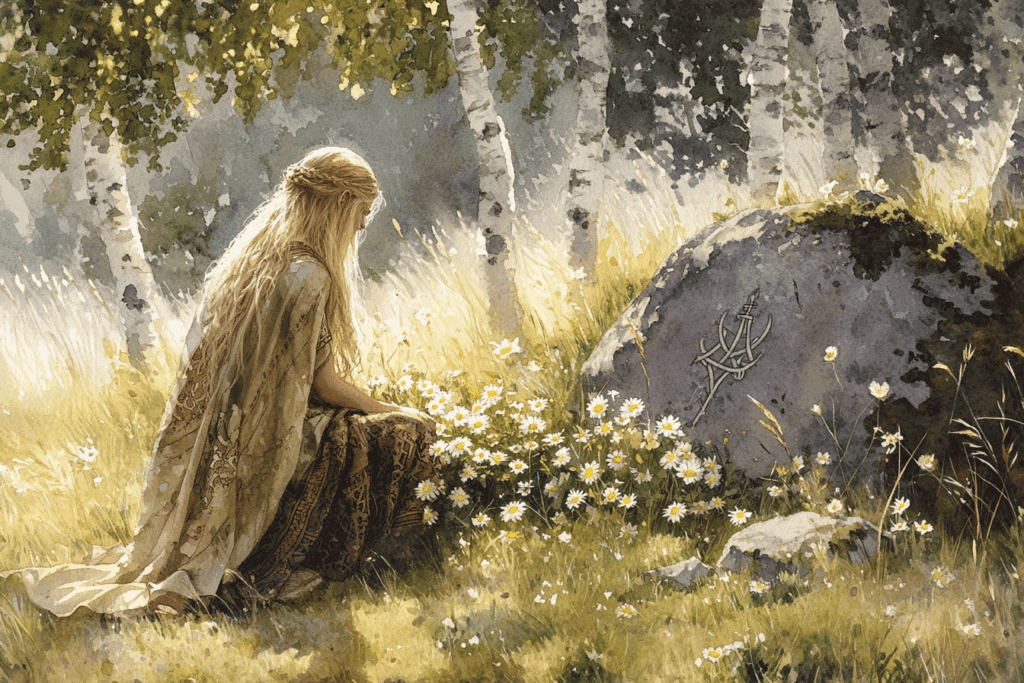No products in the cart.
June 13, 2025 8:07 am
June 13, 2025 8:07 am
In the long twilight of the warm summer nights in Central and Northern Europe, where the air hums with old stories and the land blooms briefly with bright yellow blossoms before winter’s return, the sacred and the symbolic were never separate.
Among the Norse and Germanic people, flowers played an important role not merely as plants of aesthetic or medicinal value, but as carriers of myth, ritual, memory, and cosmology.
The connection between flowers and Norse mythology is not incidental. It is deeply rooted in the worldview of the Viking people, where the realms of gods and goddesses, the living and the dead, and the seasonal cycles were bound together in rich symbolism.
These connections can still be traced in ethnographic records and historical texts.

Across culture in Central and in Northern Europe, flowers were associated with different deities and mythological stories, used in ceremonies and rituals, and believed to represent protection, fertility, rebirth, and renewal of life.
The poppy, daisy, and St. John’s Wort are just a few examples of blooms that held symbolic power.
These were not just decorative — each flower holds a sacred role, often associated with life, death, and transformation.
In Flowers and Flower Lore by Hilderic Friend (1883), St. John’s Wort was specifically connected to Baldr — the radiant Norse god of beauty, light, and peace.
Friend writes that flowers of “sun-shaped” design and golden hue were dedicated to Baldr, also known as “Baldur’s Brow.”
These blooms, believed to embody his brightness and tragic beauty, appear most often near midsummer, a season often associated with Baldr’s death and the shifting balance between life and decay (Friend 1883, p. 147–149).
This plant, often called the “flower of light and sunshine,” was not just mythic in tone — it was believed to repel dark forces, protect against spirits, and heal.
Norwegians named it Balder’s Bru, and in parts of Germany, it was thought that if the sap of St. John’s Wort was held under the tongue on St. John’s Night, it could help one see the future (Friend 1883, p. 149).

Among the Norse gods and goddesses, none is more closely associated with the bloom than the goddess Freyja. Known as the goddess of love and fertility, Freyja’s myth is woven with flowers and gold.
The viking flower most associated with her is the daisy, a symbol of purity and love, often used in midsummer rituals that celebrate fertility and beauty.
Freyja, as leader of the Valkyries and one of the Vanir, is deeply connected to cycles of life and death. The flower became a symbol of the transition from the earthly realm to the divine.
In the German book Handwörterbuch der Mythologie (Gustav Seyffarth, 1885), we find references to plants and flowers used in ceremonies to honor Freyja during summer festivals.
The Norse also attributed blooms like the poppy to realms of sleep and death — drawing lines between mortal rest and divine transition.
These flowers were used in rituals honoring Freyja, Odin, and the goddess Hel, who rules over the underworld.
In mythological lore and the tales of rural agricultural farmers and shepherds, flowers are often depicted at the borders of worlds — symbolic of the crossing between realms.

Midsummer held an especially sacred place in Viking ritual. The arrival of spring and height of the solar year was a time of bloom, of prophecy, and of sacrifice.
In Flowers and Flower Lore, Friend details the way flowers dedicated to Baldr were connected to the midsummer sun — a solar deity whose death signaled the slow decline of light (Friend 1883, p. 147).
St. John’s Wort, referred to in Germanic lands as Johanniskraut, was believed to bleed when pierced, with tiny holes in its leaves known as “Baldr’s wounds.”
In the academic ethnobotanical work of the book Dictionary of Plant Lore by D.C. Watts, we find that the plant’s use in warding off evil and its bright yellow flowers made it a powerful ritual object across Europe — and especially in Viking Age Scandinavia (Watts, 2007, p. 341).
According to the well known German scholar and folklorist Wilhelm Mannhardt’s Wald- und Feldkulte, similar floral rites were observed in May and midsummer festivals across Germany and Scandinavia.
These were often connected to a vegetation deity or female figure embodying growth and renewal — a kind of Norse May Queen or Lady of the Flowers (Mannhardt, 1875, p. 315–316).
In the Norse cosmos of nine realms centered around Yggdrasil, the world tree, flowers bloom as symbols of divine presence.
Each deity has associations with the natural world. The goddess Frigg, Odin’s wife and the mother of Baldr, is associated with domestic protection and gentle fertility.
Flowers offered to her were thought to bring peace to the home. In Zur deutschen Mythologie by Wolfgang Menzel, Frigg’s sacred aspects were often linked with blossoms in spring rites (Menzel, 1837, p. 103).
The god Thor, too, is not absent from floral symbolism. As protector of Midgard and slayer of the great wolf Fenrir at Ragnarok, Thor’s hammer was often used in agricultural blessings.
Daisies and field flowers, seen as divine and thought to represent purity and strength, were used in such blessings in honor of the god Thor.
Even Odin, the one-eyed wanderer, the god of the dead, the god of the wind and the pursuit of knowledge, has symbolic ties to the bloom.
In ritual contexts, flowers were laid at burial mounds and sacred groves as offerings to the god Odin, especially during Yule, when the veil between the living and the dead was thinnest (Grimm, Teutonic Mythology, 1835).

The role of flowers in Viking society extended beyond ritual. They were used for healing, for protection, and in daily life.
The viking flower was considered sacred in many instances — flowers were used in the naming of children, in dream interpretation, and even as symbols to guide the dead to Valhalla.
Flowers in Viking culture thus became both medicine and myth.
Mistletoe, too, held sacred connotations. In the Handwörterbuch der Mythologie (Seyffarth, 1885, p. 218–219), mistletoe was said to be the plant used to kill Baldr — not because it was evil, but because it was overlooked.
The flower holds a unique place in Germanic and Norse myth: it is the soft bloom that brings the death of the god of light, yet promises his return after the end of days.
This is the ultimate symbol of the cycle of life, of death, and of rebirth.
Ultimately, flowers in Norse mythology embody the cosmological values of the Norse people. They symbolize fertility, protection, prophecy, love, and the constant renewal of life.
They were considered sacred, often used in rituals to mark the changing seasons, honor the dead, and invite blessings from the gods.
From daisies laid in Freyja’s groves, to bright yellow St. John’s Wort gathered at midsummer for protection, to the mistletoe that struck down Baldr — flowers and Norse myth are entwined like roots in ancient soil.
As we trace these floral threads across old texts, we are reminded that the Viking worldview was one in which every bloom held a meaning, every plant was a symbol, and every flower was a bridge between the seen and unseen.
In this way, the sacred flowers of Norse mythology are not lost — they are still blooming, softly, in the lore that lingers.
Friend, Hilderic. Flowers and Flower Lore, 1883.
Watts, D.C. Dictionary of Plant Lore, 2007.
Mannhardt, Wilhelm. Wald- und Feldkulte, 1875.
Seyffarth, C.A. Handwörterbuch der Mythologie des deutschen Altertums, 1885.
Menzel, Wolfgang. Zur deutschen Mythologie, 1837.
Grimm, Jacob. Teutonic Mythology, 1835.